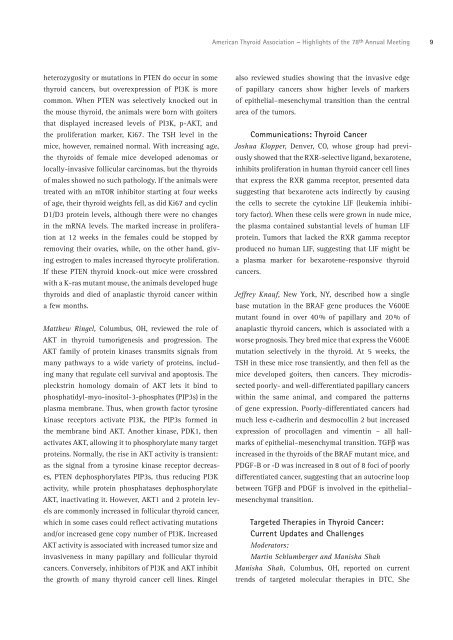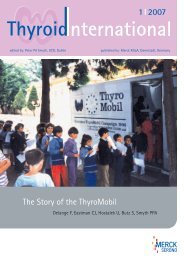Highlights of the 78th Annual Meeting American Thyroid ... - Thyrolink
Highlights of the 78th Annual Meeting American Thyroid ... - Thyrolink
Highlights of the 78th Annual Meeting American Thyroid ... - Thyrolink
Create successful ePaper yourself
Turn your PDF publications into a flip-book with our unique Google optimized e-Paper software.
<strong>American</strong> <strong>Thyroid</strong> Association – <strong>Highlights</strong> <strong>of</strong> <strong>the</strong> 78 th <strong>Annual</strong> <strong>Meeting</strong>9heterozygosity or mutations in PTEN do occur in somethyroid cancers, but overexpression <strong>of</strong> PI3K is morecommon. When PTEN was selectively knocked out in<strong>the</strong> mouse thyroid, <strong>the</strong> animals were born with goitersthat displayed increased levels <strong>of</strong> PI3K, p-AKT, and<strong>the</strong> proliferation marker, Ki67. The TSH level in <strong>the</strong>mice, however, remained normal. With increasing age,<strong>the</strong> thyroids <strong>of</strong> female mice developed adenomas orlocally-invasive follicular carcinomas, but <strong>the</strong> thyroids<strong>of</strong> males showed no such pathology. If <strong>the</strong> animals weretreated with an mTOR inhibitor starting at four weeks<strong>of</strong> age, <strong>the</strong>ir thyroid weights fell, as did Ki67 and cyclinD1/D3 protein levels, although <strong>the</strong>re were no changesin <strong>the</strong> mRNA levels. The marked increase in proliferationat 12 weeks in <strong>the</strong> females could be stopped byremoving <strong>the</strong>ir ovaries, while, on <strong>the</strong> o<strong>the</strong>r hand, givingestrogen to males increased thyrocyte proliferation.If <strong>the</strong>se PTEN thyroid knock-out mice were crossbredwith a K-ras mutant mouse, <strong>the</strong> animals developed hugethyroids and died <strong>of</strong> anaplastic thyroid cancer withina few months.Mat<strong>the</strong>w Ringel, Columbus, OH, reviewed <strong>the</strong> role <strong>of</strong>AKT in thyroid tumorigenesis and progression. TheAKT family <strong>of</strong> protein kinases transmits signals frommany pathways to a wide variety <strong>of</strong> proteins, includingmany that regulate cell survival and apoptosis. Thepleckstrin homology domain <strong>of</strong> AKT lets it bind tophosphatidyl-myo-inositol-3-phosphates (PIP3s) in <strong>the</strong>plasma membrane. Thus, when growth factor tyrosinekinase receptors activate PI3K, <strong>the</strong> PIP3s formed in<strong>the</strong> membrane bind AKT. Ano<strong>the</strong>r kinase, PDK1, <strong>the</strong>nactivates AKT, allowing it to phosphorylate many targetproteins. Normally, <strong>the</strong> rise in AKT activity is transient:as <strong>the</strong> signal from a tyrosine kinase receptor decreases,PTEN dephosphorylates PIP3s, thus reducing PI3Kactivity, while protein phosphatases dephosphorylateAKT, inactivating it. However, AKT1 and 2 protein levelsare commonly increased in follicular thyroid cancer,which in some cases could reflect activating mutationsand/or increased gene copy number <strong>of</strong> PI3K. IncreasedAKT activity is associated with increased tumor size andinvasiveness in many papillary and follicular thyroidcancers. Conversely, inhibitors <strong>of</strong> PI3K and AKT inhibit<strong>the</strong> growth <strong>of</strong> many thyroid cancer cell lines. Ringelalso reviewed studies showing that <strong>the</strong> invasive edge<strong>of</strong> papillary cancers show higher levels <strong>of</strong> markers<strong>of</strong> epi<strong>the</strong>lial–mesenchymal transition than <strong>the</strong> centralarea <strong>of</strong> <strong>the</strong> tumors.Communications: <strong>Thyroid</strong> CancerJoshua Klopper, Denver, CO, whose group had previouslyshowed that <strong>the</strong> RXR-selective ligand, bexarotene,inhibits proliferation in human thyroid cancer cell linesthat express <strong>the</strong> RXR gamma receptor, presented datasuggesting that bexarotene acts indirectly by causing<strong>the</strong> cells to secrete <strong>the</strong> cytokine LIF (leukemia inhibitoryfactor). When <strong>the</strong>se cells were grown in nude mice,<strong>the</strong> plasma contained substantial levels <strong>of</strong> human LIFprotein. Tumors that lacked <strong>the</strong> RXR gamma receptorproduced no human LIF, suggesting that LIF might bea plasma marker for bexarotene-responsive thyroidcancers.Jeffrey Knauf, New York, NY, described how a singlebase mutation in <strong>the</strong> BRAF gene produces <strong>the</strong> V600Emutant found in over 40 % <strong>of</strong> papillary and 20 % <strong>of</strong>anaplastic thyroid cancers, which is associated with aworse prognosis. They bred mice that express <strong>the</strong> V600Emutation selectively in <strong>the</strong> thyroid. At 5 weeks, <strong>the</strong>TSH in <strong>the</strong>se mice rose transiently, and <strong>the</strong>n fell as <strong>the</strong>mice developed goiters, <strong>the</strong>n cancers. They microdissectedpoorly- and well-differentiated papillary cancerswithin <strong>the</strong> same animal, and compared <strong>the</strong> patterns<strong>of</strong> gene expression. Poorly-differentiated cancers hadmuch less e-cadherin and desmocollin 2 but increasedexpression <strong>of</strong> procollagen and vimentin – all hallmarks<strong>of</strong> epi<strong>the</strong>lial–mesenchymal transition. TGFβ wasincreased in <strong>the</strong> thyroids <strong>of</strong> <strong>the</strong> BRAF mutant mice, andPDGF-B or -D was increased in 8 out <strong>of</strong> 8 foci <strong>of</strong> poorlydifferentiated cancer, suggesting that an autocrine loopbetween TGFb and PDGF is involved in <strong>the</strong> epi<strong>the</strong>lial–mesenchymal transition.Targeted Therapies in <strong>Thyroid</strong> Cancer:Current Updates and ChallengesModerators:Martin Schlumberger and Manisha ShahManisha Shah, Columbus, OH, reported on currenttrends <strong>of</strong> targeted molecular <strong>the</strong>rapies in DTC. She






